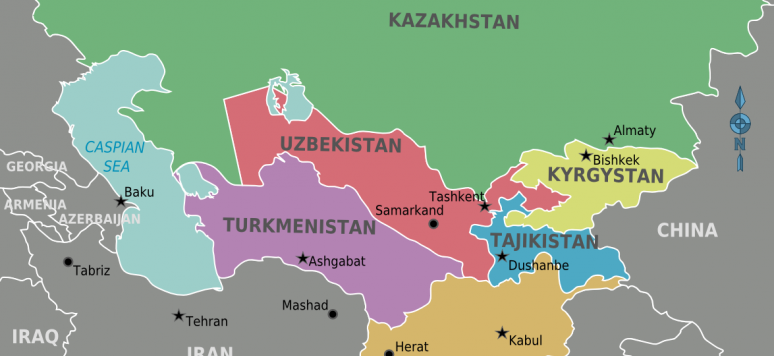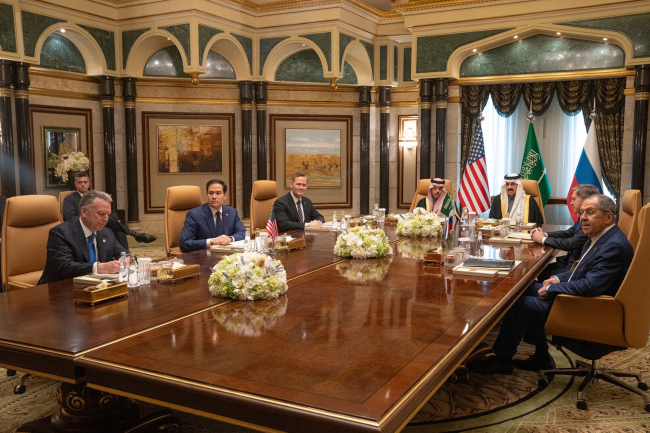U.S. Engagement Towards Central Asia: No Great Game After All?
Since the collapse of the Soviet Union in the 1990s, Washington has defined general foreign policy objectives towards the Republics of Kazakhstan, Kyrgyzstan, Tajikistan, Turkmenistan, and Uzbekistan.

They were broadly defined as helping with the integration to the world economy; the protection of Human Rights; the respect of territorial integrity; good governance and transparency; the fight against transnational threats; etc. However, there has never been a clear-cut strategy or even a vision for Central Asia as a whole that would have made the implementation of those objectives possible.
In the context of the withdrawal of Coalition forces from Afghanistan, the engagement of the United States in Central Asia must be assessed.
For the past few years, U.S. engagement towards Central Asia has been based on the think tank-empowered concept of “connectivity”[1], namely a leitmotiv seeking the expansion of business opportunities and trade linkages in order to “integrate the region more firmly into the global economy”[2]. The idea is that the U.S. can foster and profit from increased interregional connectivity in a number of areas[3] as well as bolster the resilience of Central Asian states against transnational threats. While not really shifting away from the focus on security, the U.S. policy acknowledges that a “more stable, secure Central Asia”[4] will bring about increased trade and investment with emerging Asian economies. If the traditional U.S. objectives of strengthening governance and security remain, they are now encompassed within the realm of connectivity as a new “inclusive, multidirectional, and rules-based”[5] approach to Central Asia. This offers a more realistic leverage based on U.S. comparative advantages in the region, i.e. boosting the development of soft infrastructure to facilitate trade and the transit of goods[6]. Washington recently conducted an interagency review of its Central Asian policy to adapt it to the framework of connectivity[7].
The connectivity leitmotiv was fleshed out within the framework of the “New Silk Road Initiative” (NSRI), unveiled in October 2011 alongside the stabilization effort in Afghanistan and with the aim to promote the “Northern Distribution Network” (NDN)[8] through infrastructure and trade development – namely connectivity – towards Afghanistan and the wider region. The NSRI rests on four main areas of operation: creating a regional energy market[9], strengthening trading systems and transport corridors, customs and border operations, and promoting businesses and people to people networking[10]. Altogether, the U.S. policy underlies that improving the regional environment will foster prosperity and security to Afghanistan and the wider region[11]. Nonetheless, fearing increased Russian pressure, Central Asian Republics cannot be seen as cooperating too much with Washington, especially since tangible non-U.S. alternative trade and transport corridors are already in place[12].
If the objectives of the NSRI are laudable, they were mostly perceived in Central Asia as an exit strategy from Afghanistan and a U.S. disengagement from the region, rather than a long-term reinvestment approach. From its inception, the NSRI solely focused on Afghanistan as the focal point of action to support military operations and fill the void of the 2014 withdrawal. Lacking genuine financial resources, high-ranking political support, and proper institutions to work with, the NSRI failed to create a positive outreach towards Central Asia. Furthermore, the Republics did not welcome the close policy entanglement with Afghanistan, a country that is seen as a bad omen in the whole region.
To keep reading this Editorial, please download the file below.
[1] Roman Muzalevsky (2014), CENTRAL ASIA’S SHRINKING CONNECTIVITY GAP: IMPLICATIONS FOR U.S. STRATEGY, Strategic Studies Institute and U.S. Army War College Press, November 2014
[2] Andrew C. Kuchins and Jeffrey Mankoff (2015), Central Asia in a Reconnecting Eurasia. U.S. Policy Interests and Recommendations, CSIS Russia and Eurasia Program, May 2015
[3] Namely trade, investments & FDIs, transportation, soft infrastructure, etc.
[4] An Enduring Vision for Central Asia, Remarks Antony J. Blinken, Deputy Secretary of State, Brookings Institute, Washington, DC, March 31, 2015, http://www.state.gov/s/d/2015/240013.htm
[5] Central Asia in a Reconnecting Eurasia, Remarks Nisha Desai Biswal Assistant Secretary, Bureau of South and Central Asian Affairs, Center for Strategic and International Studies, Washington, DC, May 12, 2015, http://www.state.gov/p/sca/rls/rmks/2015/242232.htm
[6] Kuchins and Mankoff (2015), Ibid
[7] U.S. reassesses Central Asia strategy, RFE/RL, March 20, 2015, http://www.rferl.org/content/central-asia-us-reassess-strategy/26911854.html
[8] Under the framework of NATO’s International Security Assistance Force (ISAF), the Northern Distribution Network (NDN) represents a U.S.-led air, rail & road military and logistical transportation system supporting resupplying activities for Coalition operations in Afghanistan.
[9] This policy so far focused on the Turkmenistan-Afghanistan-Pakistan-India (TAPI) natural gas pipeline and the Central Asia and South Asia electricity network (CASA-1000).
[10] U.S. Support for the New Silk Road, State Department, http://www.state.gov/p/sca/ci/af/newsilkroad/
[11] Richard Weitz (2015), US New Silk Road Initiative Needs Urgent Renewal, Central Asia-Caucasus Analyst, March 2015
[12] Sebastien Peyrouse (2015), The New Silk Road Initiative: are its economic underpinnings sound?, PONARS Eurasia Policy Memo No. 384, August 2015

Available in:
Regions and themes
ISBN / ISSN
Share
Download the full analysis
This page contains only a summary of our work. If you would like to have access to all the information from our research on the subject, you can download the full version in PDF format.
U.S. Engagement Towards Central Asia: No Great Game After All?
Related centers and programs
Discover our other research centers and programsFind out more
Discover all our analysesDonald Trump v. the States: the Case of New York
While the disruptive policies of the second Trump administration are being implemented at the federal level and on the international stage, they are also being felt in the federal states and major cities across the country. In the spring of 2025, several cases involving the state and city of New York demonstrate that the president’s attacks on environmental protection, the separation of powers, freedom of speech, etc., are also being carried out at the local level.
How the US under Trump Became a Strategic and Ideological Adversary of Europe
The Europeans' worst security nightmare seems to be coming true: on Tuesday, February 18, 2025, U.S. Secretary of State Marco Rubio and Russian Foreign Minister Sergey Lavrov met in Saudi Arabia to initiate the normalization of relations between their two countries. The meeting also aimed to set up peace negotiations for Ukraine. However, despite having the potential to affect the entire continent, the discussions took place without the Europeans or the Ukrainians being present.
Will Trumpian Authoritarianism Lead to a Constitutional Crisis?
Since his return to the White House on January 20, 2025, President Donald Trump has signed around sixty executive orders to implement his political agenda. Numerous other measures have also been introduced by the White House and the new Department of Government Efficiency (DOGE) as part of these orders.
Trump’s Second Term: Laying the Groundwork for a New Trade War
In a statement released on February 1, 2025, President Trump announced the implementation of a 10% tariff on Chinese goods and a 25% tariff on imports from Canada and Mexico. While the former took effect via executive order on February 4, the latter were granted a 30-day reprieve. Sanctions targeting European Union (EU) products are said to be imminent.








